Binance Futures Review: Fees, Leverage & Country Restrictions

Summary: Binance Futures is the largest crypto futures exchange, often exceeding $80B in daily trading volume. It offers 500+ pairs, up to 125x leverage, and fees from 0.02% maker, 0.05% taker.
Traders choose between perpetual or quarterly contracts, balancing funding costs and settlement timing. Access is restricted in the US, Canada, Netherlands, Cuba, Iran, DPRK, and parts of Ukraine.
Binance Futures is the largest crypto derivatives exchange, offering deep liquidity on 400+ crypto pairs, high leverage up to 125x, and competitive low fees for high-volume traders.
Supported Contracts
500+ trading pairs across USDⓈ-M and Coin-M margined
Futures Trading Fees
Starting from 0.02% maker & 0.05% taker with BNB discounts
Regulation and Licensing
Licensed in France, Dubai, Australia, and El Salvador
What Is Binance Futures?
Binance Futures is the derivatives arm of Binance, allowing trading on cryptocurrency price movements without owning the underlying assets. Traders use contracts that follow the value of coins like Bitcoin or Ethereum, with profits and losses settled in crypto or stablecoins.
Since its 2019 launch, Binance Futures has become the largest crypto futures exchange by daily volume, often exceeding $2.5 trillion in monthly volume. The platform supports over 500 trading pairs, covering major assets and niche tokens, with deep liquidity that limits slippage even during volatility.
Integration with the main Binance exchange enables instant transfers between spot and futures wallets, but full ID verification is required. Access is restricted in regions such as the United States, Ontario, and sanctioned countries, with some European users limited to Binance Futures Credits due to regulations.
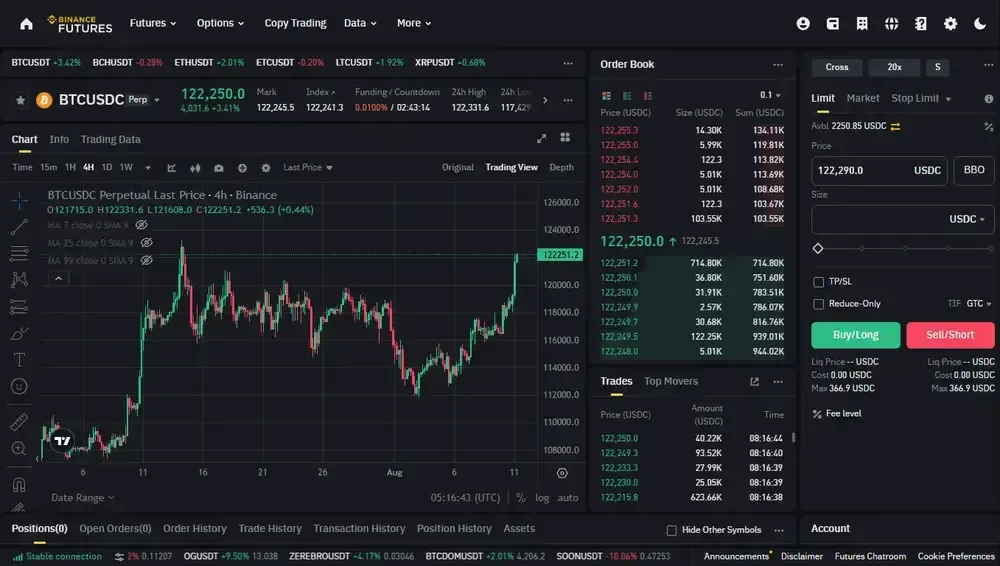
How to Use Binance Futures
Getting started with Binance Futures is not difficult if you follow a structured process. These steps cover setup, navigation, and trade execution from start to finish:
- Enable Futures: Complete Binance’s Futures short quiz and agree to risk disclosures before unlocking the futures trading interface on your account.
- Fund Your Futures Wallet: Transfer USDT (excluded for EEA users), USDC, or crypto collateral from your spot wallet, ensuring sufficient margin for planned trade sizes and risk buffers.
- Select a Trading Pair: Use the search bar to find desired perpetual or quarterly contract from the hundreds available across cryptocurrencies.
- Choose Margin Mode: Decide between Isolated (limits loss to set collateral) or Cross (shares all margin) before placing your first futures order.
- Adjust Leverage: Use the slider to set appropriate leverage, remembering higher multiples reduce liquidation distance and require stricter risk control discipline.
- Analyze the Chart: Apply technical indicators and monitor order book depth to determine entry, exit, and stop-loss levels matching your trade plan.
- Place an Order: Select market, limit, or stop order type; enter size; set take-profit and stop-loss triggers; then confirm execution details.
- Monitor Your Position: Track unrealized PnL, margin ratio, and liquidation price continuously; adjust stops or add collateral to protect profitable trades.
- Close the Position: Exit via limit or market order, or let a take-profit or stop-loss trigger automatically when conditions are met.
- Review and Improve: After closing, check trade history, funding costs, and execution notes to refine strategy and reduce mistakes in future trades.
Types of Futures Contracts on Binance
Binance offers two core contract families that behave differently with time and costs, affecting strategies and holding preferences. Understanding perpetual funding versus quarterly settlement helps you choose flexibility for trading or predictability for hedging and longer holds.
Perpetual Futures (Swap Contracts)
Perpetual contracts never expire, tracking spot with a funding mechanism that exchanges periodic payments between longs and shorts to anchor prices. On Binance, most pay funding every eight hours, with a base 0.01% interval rate plus a premium reflecting price divergence.
Major pairs allow up to 125x leverage; smaller altcoins use lower caps, and USDⓈ-M versus Coin-M determine margin and settlement. Funding can materially impact multi-day holds during extreme sentiment, prompting many traders to prefer quarterlies when carrying positions longer.
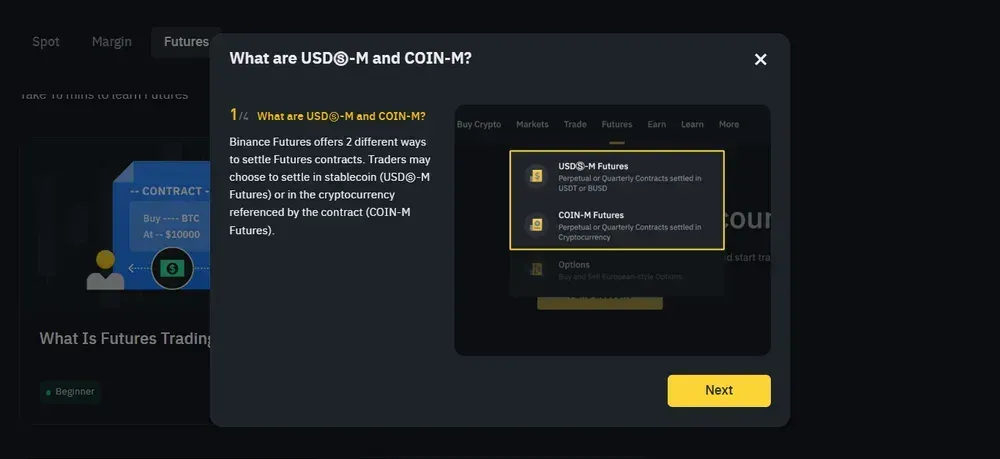
Quarterly Futures (Delivery Contracts)
Quarterly contracts expire on fixed dates and settle without funding, naturally converging toward spot as delivery approaches and removing ongoing carry costs. Traders use them for longer-term hedges, premium capture, and avoiding elevated funding during exuberant periods that would erode leveraged positions.
Contracts often trade at a premium or discount, enabling cash-and-carry strategies, with the basis closing as settlement nears each quarter. If you prefer avoiding delivery, plan to roll or close ahead of expiry, using calendar reminders to stay disciplined.
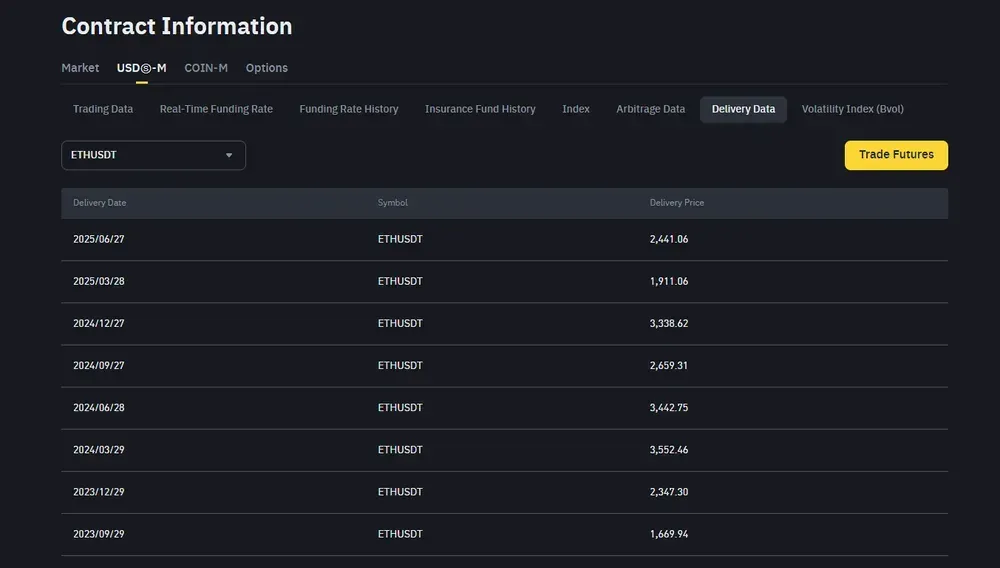
Supported Cryptocurrencies and Leverage Options
Binance Futures lists hundreds of pairs across 409 coins, letting you trade majors, DeFi names, layer-ones, metaverse, and popular meme tokens. That breadth consolidates strategies on one venue, reducing multiple accounts and enabling quick rotation between BTC, ETH, and selective altcoins.
Leverage scales by asset and position size: majors reach 125x, mid-caps often 50x-75x, smaller volatile coins around 20x-25x. A tiered margin system reduces maximum leverage as notional grows, automatically increasing maintenance requirements to protect market stability and platform solvency.
Hedge Mode enables simultaneous long and short legs on one contract; One-Way Mode maintains a single net exposure with simpler bookkeeping. Experienced traders often favor modest leverage, typically 5x-20x, reserving higher settings for small, short-term scalps and tightly risk-managed experiments.
Binance Futures Fees and Funding Rates
Binance runs a maker-taker schedule with industry-low rates, shaved further by volume tiers and optional fee payments using BNB. Perpetuals also include funding transfers between traders every eight hours, while quarterly futures avoid funding entirely and converge into settlement prices.
Here is how the main costs stack up, and where unaware traders usually leak performance:
- Base fees: Binance Futures fees start at 0.02% for makers and 0.05% for takers at VIP 0, with tiered discounts available and an optional 10% reduction when paying with BNB.
- Funding: Perpetual funding accrues every eight hours, with a 0.01% baseline plus premium, transferring between longs and shorts rather than Binance.
- Quarterlies: Quarterly futures skip funding entirely, leaving only entry and exit fees plus any basis premium or discount converging by expiry.
- Liquidations: Clearance fees apply when positions fail maintenance, reducing residual collateral and emphasizing proactive stops, sizing, and strict margin monitoring discipline.
- Comparative context: Binance’s base taker beats common 0.05%-0.055% levels, while maker rates generally match before promotional rebates elsewhere.
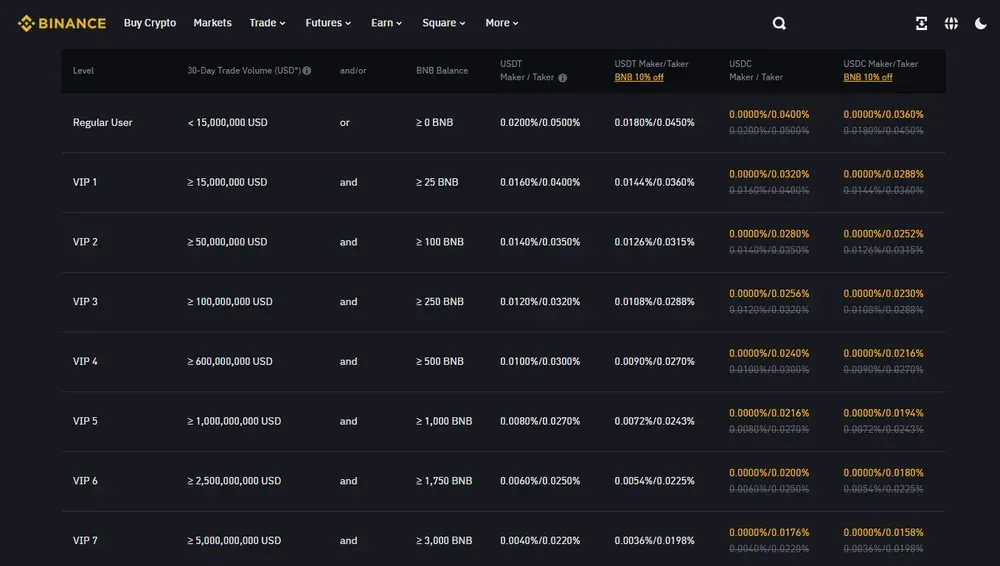
Risk Management Tools and Liquidation Mechanisms
Leverage amplifies outcomes, so Binance’s toolset and liquidation design matter as much as charts and fees for long-term survival. Using the right margin mode, stop logic, and sizing helps you sidestep costly clearance fees and avoid avoidable liquidation cascades.
Margin Modes
Isolated margin caps risk per position by ring-fencing collateral, while Cross allows your entire futures balance to support all open exposures. Cross margin suits hedges and large cushions; isolated margin suits speculative altcoin trades where you want clearly predefined maximum losses.
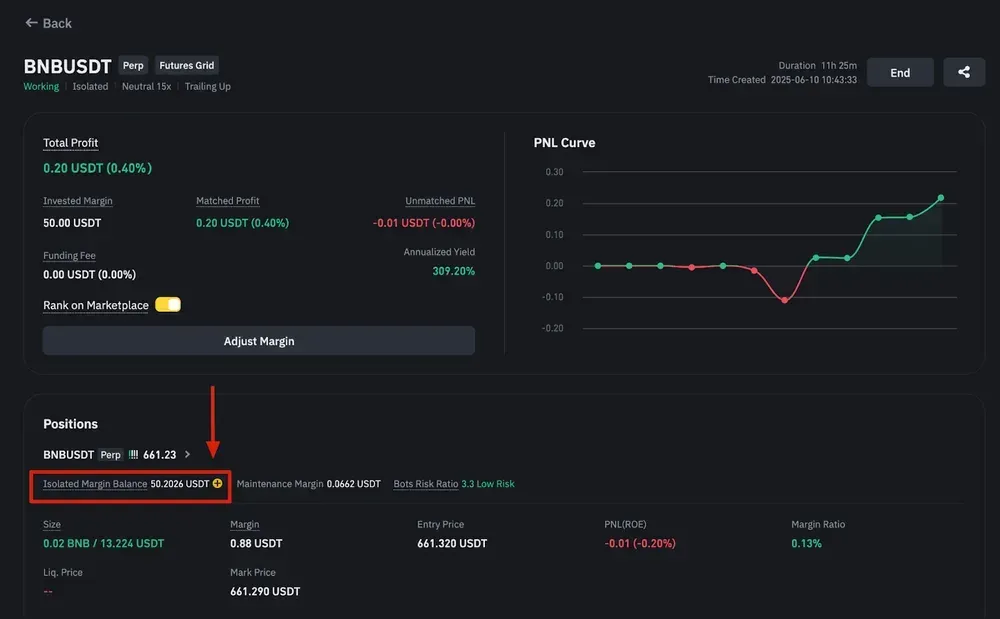
Order Types and Stops
Stop-loss, take-profit, and trailing stops are first-line defenses, and can be attached at entry or modified afterward easily. Calculator tools preview PnL, liquidation estimates, and risk before committing, encouraging disciplined sizing rather than guesswork under pressure.
Main order types and stops include:
- Stops: Always predefine exits with a stop and target; use reduce-only orders to prevent flips, and consider trailing logic in trends.
- Sizing: Use the calculator to size positions so a routine adverse swing does not threaten liquidation, especially when volatility is elevated already.
- Margin: Monitor margin ratio carefully; add collateral or reduce size before alarms trigger, rather than relying on alerts during violent market moves.
- Mode: Prefer isolated margin for speculative alt positions; reserve cross for hedges and core exposure where additional cushion reduces liquidation risk.
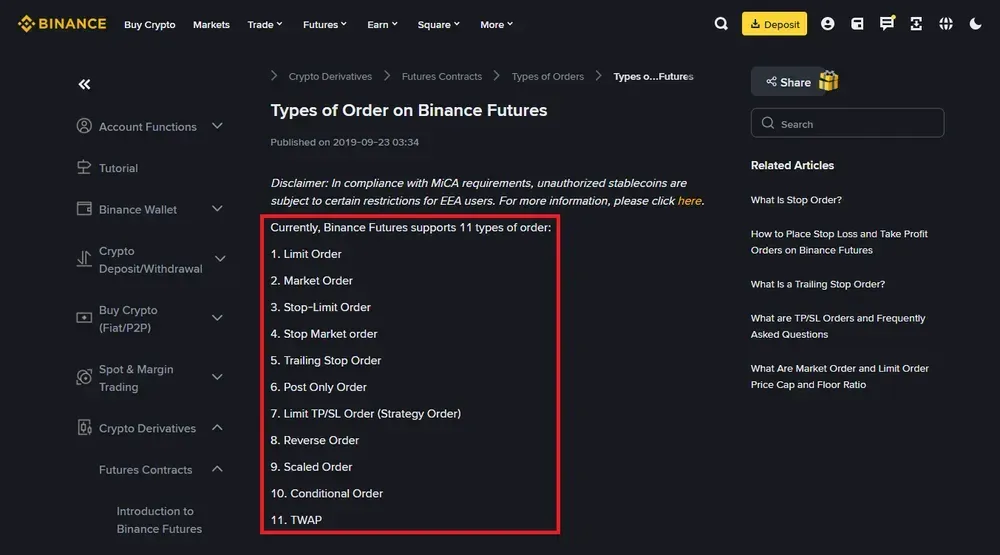
Liquidation Engine and Insurance
Binance liquidates using mark price, first canceling open orders, then attempting partial reductions to restore maintenance margin before resorting to full closure. Insurance funds per contract absorb shortfalls, with auto-deleveraging as a last resort, signposted by an ADL indicator on open positions.
Liquidation clearance fees further penalize poor risk control, reinforcing the value of planned exits and early margin adjustments during turbulent sessions. In practice, partial liquidations can leave salvaged positions, but avoiding the sequence entirely remains cheaper and emotionally far less disruptive.
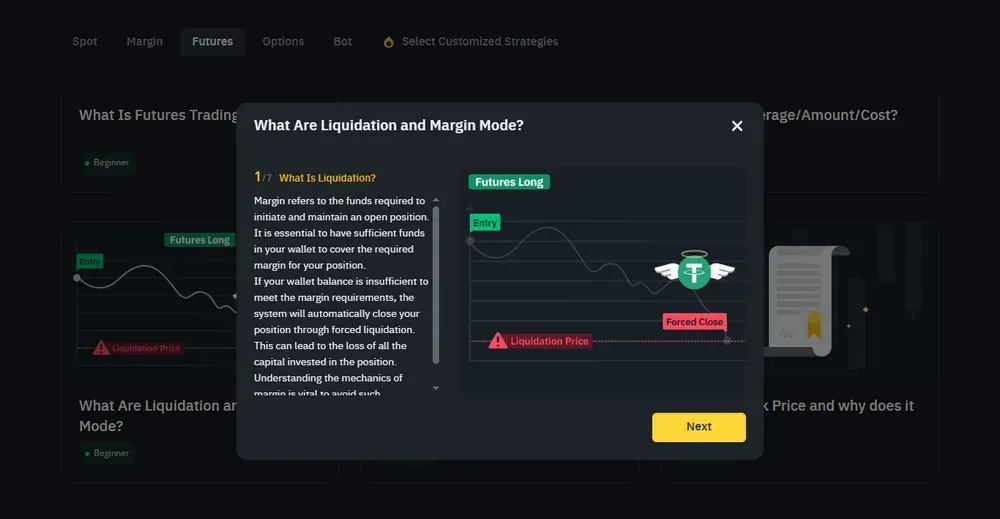
Security and Regulatory Considerations
Binance uses cold storage, multi-signature controls, 2FA, device management, withdrawal whitelists, anti-phishing codes, and optional hardware security keys for accounts. After a 2019 hot-wallet breach, Binance reimbursed users through SAFU and pursued ISO 27001 certification, expanding previous monitoring.
All Binance Futures users must complete identity verification, including ID submission, proof of address, and sometimes additional checks for higher account privileges. KYC ensures compliance with global regulations, helps prevent fraud and money laundering, and is mandatory before enabling futures trading features.
Futures trading is prohibited in the United States, Canada, Netherlands, Cuba, Iran, North Korea, Crimea, Donetsk, and Luhansk. These bans stem from regulatory licensing requirements, economic sanctions, or geopolitical conflicts enforced by national governments and international authorities.
Pros and Cons of Binance Futures
Evaluating strengths and trade-offs clarifies whether Binance aligns with your priorities, legal constraints, and tolerance for platform and market risk. Below are concise takeaways distilled from the platform’s design, fee schedule, security posture, regional access, and long-term trading ergonomics.
Pros
Advantages highlight reasons traders concentrate volume here:
- Liquidity: Deep order books and leading daily volume enable tighter spreads and larger fills, reducing slippage and improving execution quality across majors.
- Markets: Hundreds of futures pairs across majors and altcoins consolidate strategies on one venue, enabling diversified setups and convenient hedges or rotations.
- Instruments: Perpetuals and quarterlies provide flexibility between funding-anchored trading and funding-free positioning for hedges or cash-and-carry strategies.
- Fees: Base maker 0.02% and taker 0.05% undercut many competitors, with volume tiers and BNB payments lowering effective costs further.
- Platform: Feature-rich web and mobile apps support advanced order types, calculators, multi-chart layouts, and reliable performance during heavy volatility events.
- Security: Proof-of-reserves, user protections, SAFU reimbursements historically, and futures insurance funds collectively bolster confidence despite industry-wide risks.
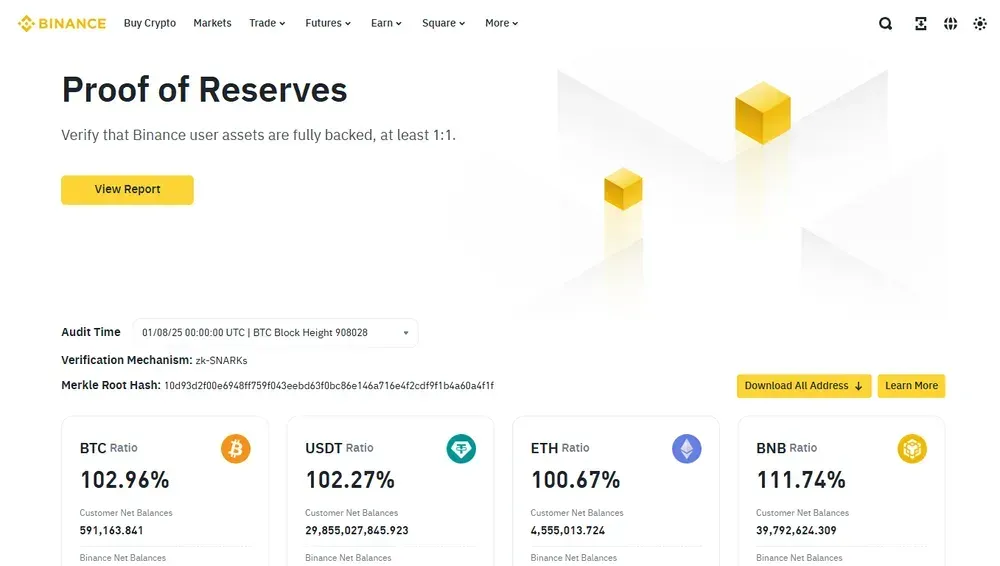
Cons
Disadvantages flag constraints and behaviors that require extra caution or contingency planning:
- Regulation: Uncertainty affects availability across regions, requiring vigilance and readiness to migrate or unwind positions promptly if access is curtailed.
- Jurisdictions: Unavailable for US persons and some countries, with 2024 EEA futures credits and pauses affecting access to direct leverage.
- Complexity: A powerful interface can overwhelm beginners, increasing misuse risks like over-leverage or missing stops without education, practice, and discipline.
- Funding: Perpetual funding becomes expensive during extreme sentiment, materially eroding returns on multi-day holds when positioned on the paying side repeatedly.
- Support: Scale occasionally strains customer support responsiveness, making prevention and self-service tooling especially important during account recovery or anomaly investigations.
- Niche liquidity: Some exotic pairs exhibit wider spreads and thinner depth, so size carefully and test fills before committing larger orders.
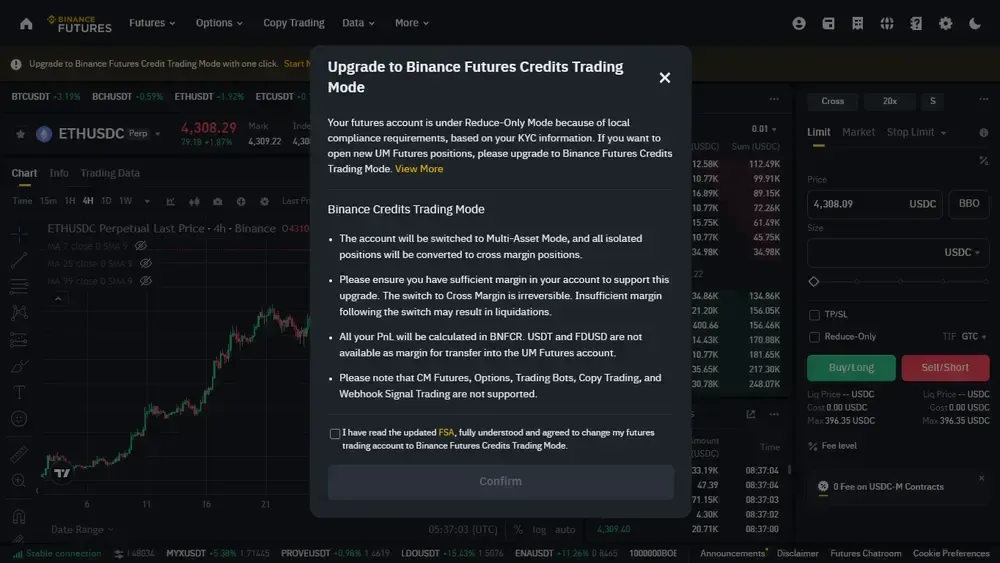
Binance Futures vs Other Futures Platforms
Alternatives like Bybit, OKX, Kraken Futures, and CME target different priorities, from simplicity or unified accounts to regulation or institutional access. Binance generally leads on liquidity, breadth, and taker fees, though preferences vary with location, leverage needs, and desired product scope.
Binance Futures vs. Bybit
Bybit’s interface is widely praised for simplicity, copy trading, and early listings of niche altcoins, often before larger exchanges. Binance offers fuller ecosystem integration, deeper overall liquidity, and slightly lower taker fees, though Bybit maintains an edge in rapid altcoin market coverage.
For a deeper dive, read our full Binance vs Bybit review.
Binance Futures vs. OKX
OKX competes strongly with unified accounts, broad derivatives including quarterlies and options, and a growing OKX wallet attracting onchain derivatives traders. While fees are near parity, Binance generally edges taker pricing and lists more altcoin futures with thicker order books on popular contracts.
Explore the differences in our detailed Binance vs OKX review.
Binance Futures vs. Kraken
Kraken emphasizes regulation and security, holding a MiCA license that strengthens its position in European regulated markets. Liquidity and breadth trail Binance significantly, but some prefer Kraken’s compliance focus and fixed rollover fees for certain long-term hedging strategies.
Final Thoughts
For active traders, swing participants, and hedgers outside restricted jurisdictions, Binance combines liquidity, variety, and low costs unusually well. Begin with small size or testnet, learn margin modes, attach stops immediately, and prefer moderate leverage to preserve longevity through inevitable drawdowns.
Expect Binance to keep iterating features, listings, and compliance as global rules evolve, preserving its liquidity advantage across cycles. Your edge will come from disciplined sizing, planned exits, and contract selection that minimizes hidden costs like funding during extended holds.
Frequently asked questions
Can I practice trading on Binance Futures without risking real money?
Yes. Binance offers a Futures Testnet where you can trade with simulated funds in a live-like environment. It’s accessible at testnet.binancefuture.com and is ideal for learning order types, leverage mechanics, and interface navigation before committing real capital.
Does Binance Futures support automated trading strategies?
Yes. Binance provides a secure API for programmatic trading, enabling you to connect bots for strategy automation. You can run grid bots directly from the interface or integrate third-party trading systems, but always test thoroughly in the Testnet to avoid costly coding errors.
How do I withdraw profits from Binance Futures?
You must first transfer funds from your Futures wallet back to your Spot wallet inside Binance. Once there, you can convert profits into fiat (if supported in your region) or withdraw crypto to an external wallet, paying only standard network fees for the transfer.
What happens to open positions during scheduled Binance maintenance?
During maintenance, you cannot place new orders, but existing positions remain open and are still subject to price movements. Binance usually schedules upgrades during low-volume periods and gives prior notice, so it’s wise to close or adjust positions beforehand to avoid unexpected risks.
%2520(1).webp)
Written by
Tony Kreng
Lead Editor
Tony Kreng, who holds an MBA in Business & Finance, brings over a decade of experience as a financial analyst. At Datawallet, he serves as the lead content editor and fact-checker, dedicated to maintaining the accuracy and trustworthiness of our insights.

.webp)
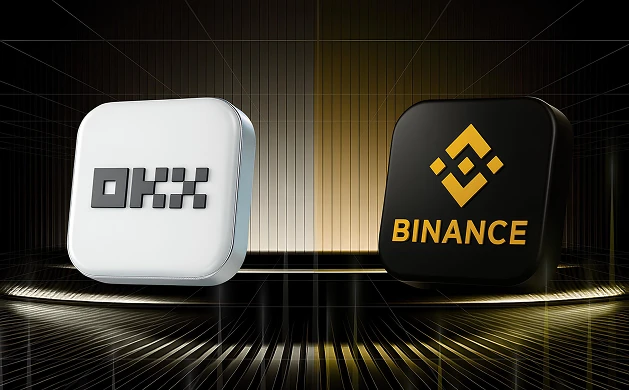
%25201%2520(1).webp)

.webp)




